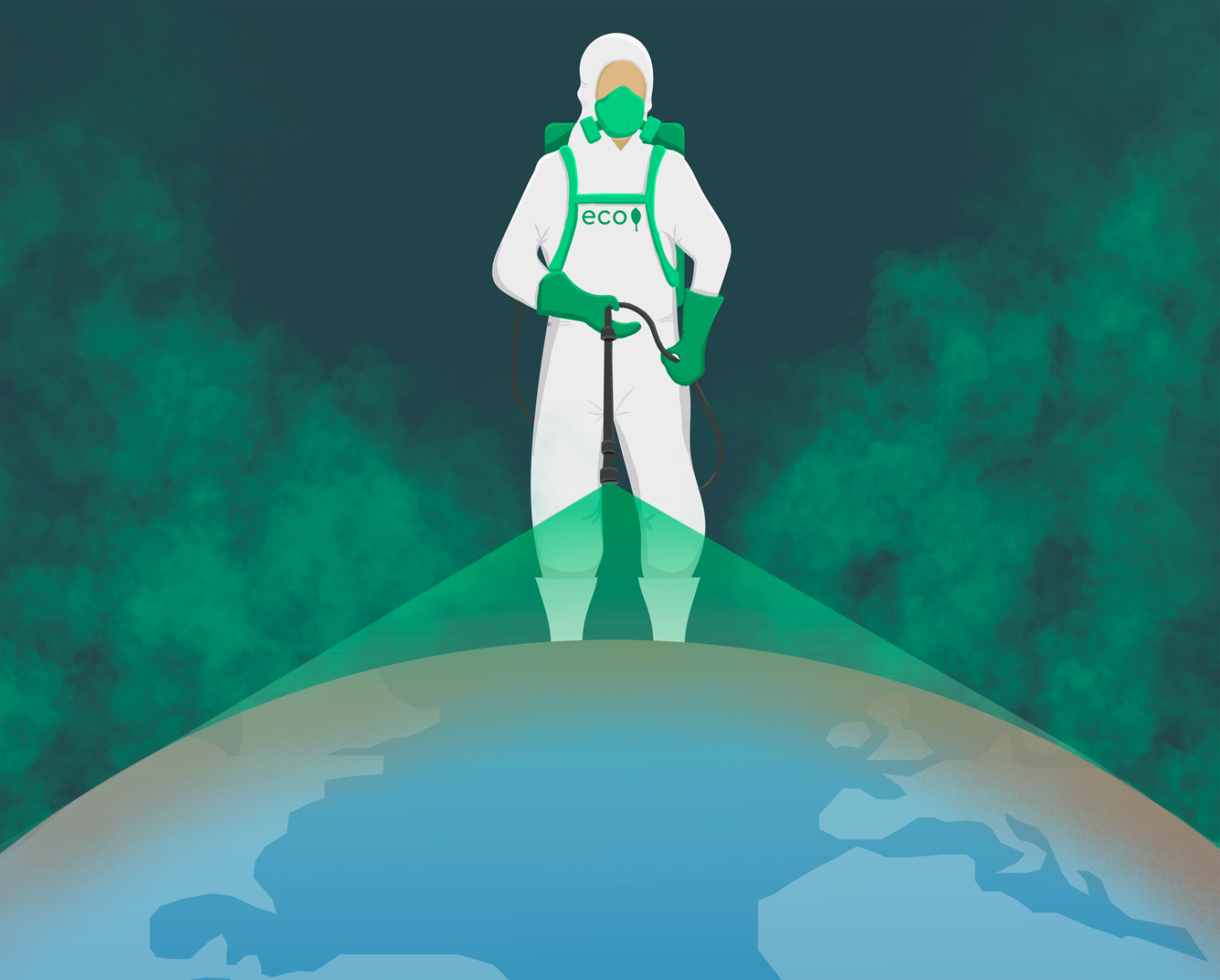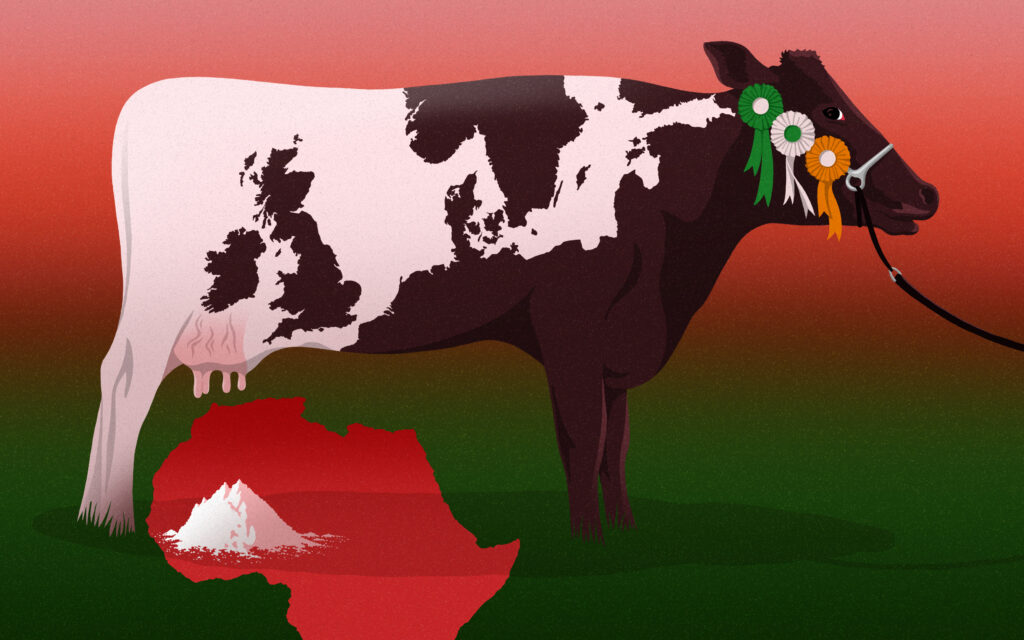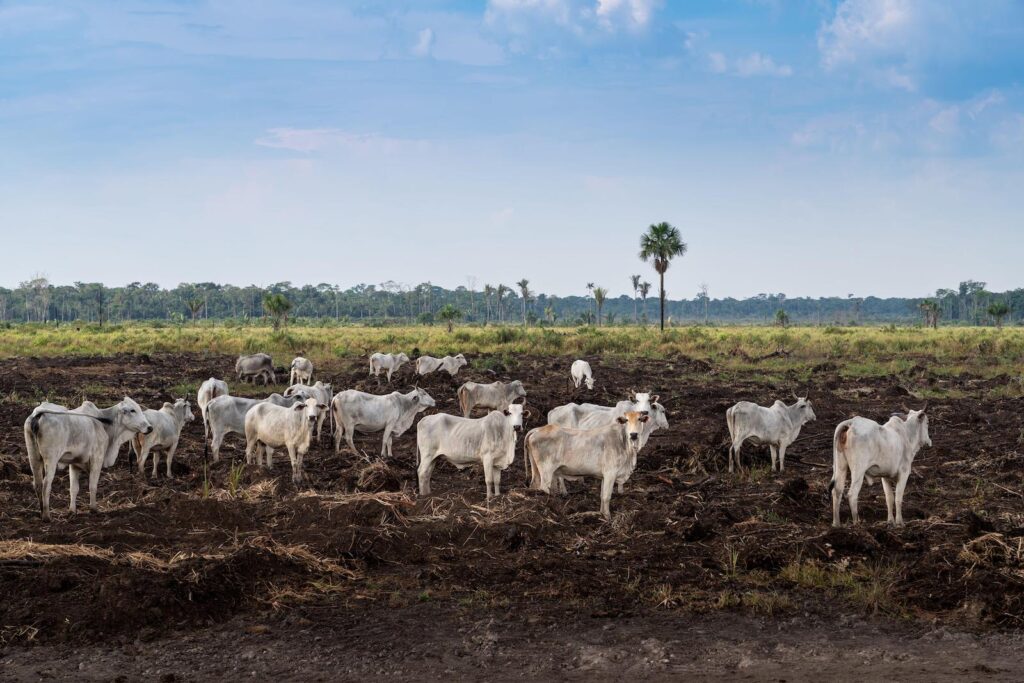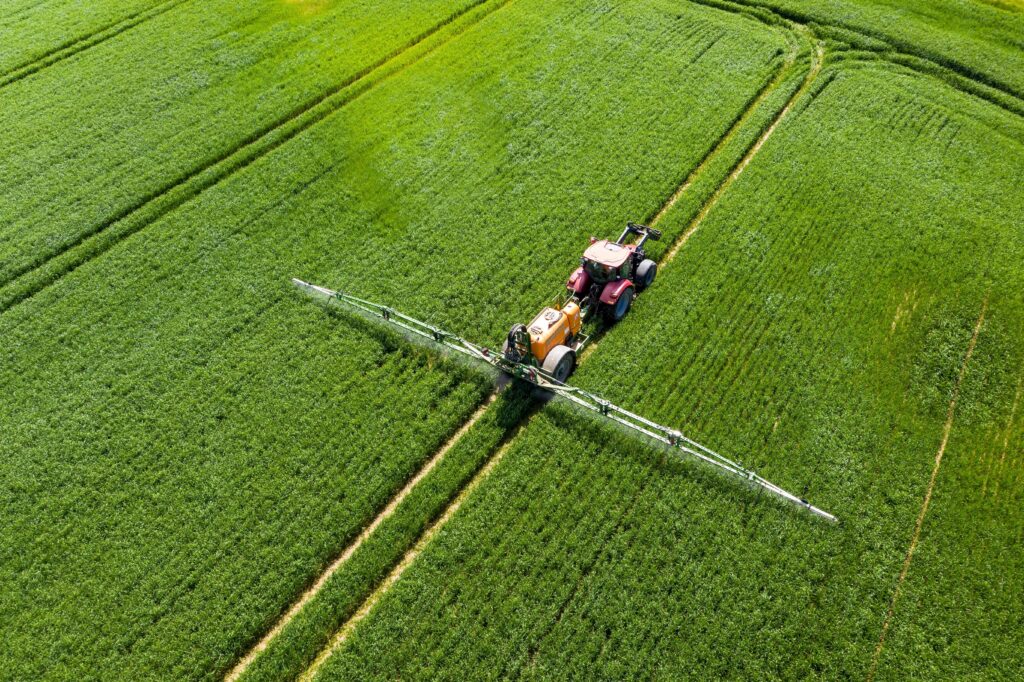This article was published as part of the launch of DeSmog’s Agribusiness Database, where you can find a record of companies and organisations’ current messaging on climate change, lobbying around climate action, and histories of climate science denial.
“Like a pandemic, climate change is an inevitable threat that we must address before it is too late,” reads a June 2020 statement. “As the economy and agriculture begin to build back with the gradual easing of the COVID-19 restrictions, we need to support a recovery for farmers that puts the fight against climate change and biodiversity loss at its core.”
The speaker? Not Greta Thunberg, Alexandria Ocasio-Cortez or Al Gore. Not, in fact, any environmentalist you might care to imagine. Instead, it was Erik Fyrwald, Chief Executive Officer of Syngenta Group — one of the world’s five largest pesticides manufacturers, a major consumer of fossil fuels, and now a company marketing its products as a solution to climate change.
Syngenta’s messaging — alongside similar campaigns from the other “big five” global pesticides producers Bayer, BASF, Corteva and FMC — reflects a sudden transformation within the agricultural world.
After decades of denial and delay by big agribusiness, the pesticides industry now appears to have become a climate champion.
‘Waking up on climate change’
The pesticides market is dominated by a small handful of companies — Bayer (which acquired Monsanto in 2018), Corteva (formerly Dow and DuPont), Syngenta, BASF and FMC — whose hazardous products a United Nations report said have “catastrophic impacts on the environment, human health, and society as a whole” amid a global insect die-off and legal battles over carcinogenic effects of products once marketed as harmless.
Together, these firms control the vast majority of the enormous global pesticides market. “As a whole, the market for agrochemical pesticides has grown steadily since 2006,” reported a 2019 study. The most recently available federal data, from 2011 and 2012, shows that nearly 6 billion pounds (2.7 billion kilos) of pesticides were used each year worldwide, including 1.1 billion pounds (0.49 billion kilos) in the US alone.
These chemicals play a key role in the fossil fuel-dependent farming systems that spread worldwide during the 20th century and have created complex ecological problems while boosting yields — including driving climate change.
“Pesticides are the lynchpin of an unsustainable industrial agriculture system,” says the Pesticide Action Network campaign group. “The current food system is responsible for one-third of global greenhouse gas emissions; it’s also fully dependent on oil both for transport and because pesticides and fertilizers are petrochemically-derived.”
Pesticides manufacturing also has its own significant direct carbon footprint — but a lack of data and independent research has made it difficult to find reliable numbers, researchers say.
“With the rapidly growing interest in greenhouse gas emissions (often embodied in Life Cycle Assessment or ‘carbon footprinting’), there are many studies using estimates of the emissions from agricultural pesticide manufacturing,” a 2009 study by Cranfield University reported. “Unfortunately, it seems that almost no two studies use the same number for the same ingredient. This is mainly due to the paucity of original data on pesticides, often because of commercial confidentiality.”
That study was prepared for the Crop Protection Association, a British organisation that’s dubbed itself “the voice of the UK plant science industry” and counts all of the big five pesticides manufacturers among its members.
It’s no secret that pesticides manufacturing is closely wedded to fossil fuels, which are the primary driver of climate change. Some pesticides use oil and gas industry products as key ingredients, while others are synthesized from naturally occurring compounds — and both types often rely on fossil fuels for the heat and energy necessary for chemical reactions.
The industry represents a significant chunk of the world’s fossil fuel demand. “Currently, about 20 percent of oil is used for petrochemicals and 24 percent is used for agriculture, which includes manufacturing, production, processing, transportation, marketing, and consumption,” notes a 2020 paper published in The Lancet Diabetes and Endocrinology journal. “Oil is used to make chlorobenzene, which in turn is used to synthesise [the pesticide] DDT. Similarly, many pesticides such as neonicotinoids, pyrethryoids, and glyphosate formulants are produced from gas and oil.”
Like what you’re reading? Support DeSmog by becoming a patron today!
Big agribusiness also wields enormous political leverage. From 1998 to 2020, the agricultural industry spent more on lobbying in the US than the defense industry, according to the Center for Responsive Politics. And for decades, agricultural advocacy organizations like the American Farm Bureau Federation used this clout to campaign in Washington DC against efforts to curb greenhouse gas emissions.
“Everyone on the Hill knew that there was a division of labor,” Joseph Goffman, Executive Director of Harvard Law School’s environmental and energy program, told InsideClimate News in 2018. “Oil companies argued that consumers would pay a price at the pump for regulation of fossil fuels. And the farmers could argue that they were a far more economically sensitive group of fuel users and would be seen more favourably than oil would be.”
Last year, however, proved to be a brutal year for many US farmers who faced catastrophic Midwest flooding. And advocates for big agribusiness have described increasing concern that their industry might be left out of conversations about climate change. This year seems to be a moment when, as Politico put it in December, “farmers are waking up on climate change.”
Amid this awakening, pesticides manufacturers are now heavily promoting strategies to convince farmers and policymakers that their products still have a large role to play as the world warms.
Companies like Syngenta acknowledge that industrial agriculture has contributed significantly to climate change but say they are now working to find less polluting ways to grow crops. “Unpredictable weather events are becoming more common – from flooding to drought and extreme heat to early frost – and agriculture itself is part of the problem,” Syngenta spokesperson Paul Minehart said in an email to DeSmog, describing the company’s targets aimed at reducing greenhouse gas emissions from both farming and pesticides manufacturing.
“Agriculture can help meet the global Net Zero ambition by reducing emissions, locking more carbon in the soil and providing space to reforest,” he said. “As far as crop protection products are concerned, yes they can play a role in helping reduce [greenhouse gases], reduce erosion and save water.”
‘Selling the same old stuff’
Less than a decade ago, surveys reported that nearly half of US farmers weren’t convinced climate change was happening. Just eight percent said they thought human activities were responsible for warming.
But earlier this year, a Syngenta-funded poll found that 87 percent of large-scale farmers in the US, France, China, Brazil, India and across Africa said that they’d already experienced climate change firsthand — and a majority rated the effects on their farms “high impacts.”
In response, the pesticides industry is putting huge resources in marketing climate action strategies attached to two labels: precision agriculture, and regenerative agriculture — with both items falling under the even broader umbrella terms “climate smart” or “climate resilient” agriculture.
Genetic modification plays a significant role in most of the strategies backed by pesticides manufacturers. “For example, planting genetically modified seeds enables farmers to use reduced tillage and no till practices, which has resulted in a substantial reduction in carbon dioxide emissions,” a video by Bayer, the manufacturer of glyphosate-based pesticides like RoundUp, says. “And as these tactics are adopted, farmers can help mitigate climate change and its impacts. That’s not just good for farmers, it’s good for all of us.”
These tactics have some potential to help farms cut their greenhouse gas emissions, but how much is highly debated.
At a policy level, critics fear that terms like “climate smart” and “resilient” farming are so vague that they’re vulnerable to greenwashing. “There is no precise definition for ‘climate smart agriculture’ and deliberately so,” the Down to Earth blog reported in 2016, adding that, for example, the Global Alliance for Climate Smart Agriculture “leaves it to its members to determine what ‘climate smart agriculture’ means to them. There are no social or environmental safeguards.”
Critics also argue that the dual “precision” and “regenerative” climate strategies pesticides manufacturers are now pushing could in fact maintain — or even increase — the world’s dependence on fossil-fuel based agricultural products.
“They’re just trying to sell the same old stuff under different labels,” says Stacy Malkan, co-founder of the food industry watchdog group US Right to Know. “The bottom line is they’re chemical companies and they want to sell more chemicals.”
It’s not just campaigners who are concerned. A 2017 report by the UN’s Special Rapporteur on the Right to Food found that, “it is commonly argued that intensive industrial agriculture, which is heavily reliant on pesticide inputs, is necessary to increase yields to feed a growing world population, particularly in the light of negative climate change impacts and global scarcity of farmlands”. But noting that 200,000 people die of acute pesticides poisoning each year, it added that “reliance on hazardous pesticides is a short-term solution that undermines the rights to adequate food and health for present and future generations.”
Beyond sustaining the pesticides-heavy status-quo, there are other problems with these approaches: from pricing out farmers in developing countries, to the technology not actually working, and a paucity of data to actually measure success.
Precision agriculture
One of the oldest truisms about farming is that it’s an uncertain business — so much depends on the weather. So-called “digital” and precision agriculture strategies rely on technology to enable farmers to control the inputs and outputs of their farms down to the most minute details in an attempt to insulate each individual farm against the growing risks of operating in a changing climate.
Sensors collect pinpointed data about soil moisture, nutrient levels, and leaf temperature and wetness. GPS-guided tractors can navigate at night, in fog or rain. Agricultural robots spray, prune and thin crops. Corteva Agriscience says it has trained over a thousand pilots to fly data gathering drones over farms. FMC’s Arc farm intelligence software uses machine learning to forecast exactly where insects, weeds and diseases are likely to arrive.
Precision agriculture “uses technology to sharpen focus, zero in on, and narrow down, for example, land mapping, soil sampling, fertilization, pest and disease control, and weather alerts. It will pick out a puddle in a field or a change in gradient within a tea field for treatment,” The Stir, a coffee and tea trade publication, explains. “IBM estimates that PA [precision agriculture] generates 500,000 data points per farm each day.”
These tactics are marketed by the big five pesticides manufacturers as a central tenet of their responses to climate change. Bayer, for example, advertises a “Smart Fields” strategy for “digitalization in farming,” adding that “development of climate-smart solutions including digital farming and improved plant breeding technologies will help reduce agriculture’s impact on climate change in the future”.
Read more: Digital and Precision Agriculture – Criticisms and Concerns
The biggest problem with this precision approach, critics say, is that all of these high tech solutions are extremely expensive.
“Not many farmers use precision agriculture technologies, although the percentages vary by region,” Tamme van der Wal, a Wageningen University data scientist, wrote in a 2019 Future Farming opinion column. “The overall complaint is that the technology is too expensive, too complex and farmers don’t have a reasonable outlook on the return on their investment.”
That’s a huge barrier for small-scale farmers, especially in places like South America and Africa, where, for example, a farming revolution promised by organizations like the Alliance for a Green Revolution in Africa wound up leaving farmers in debt, criticis say, while enriching multinational agribusinesses.
The technologies on which precision agriculture relies may also prove to be ineffective because of climate change – like, for example, one of the world’s most widely-used pesticides. “[O]verreliance on glyphosate for weed control under changing climatic conditions may result in more weed control failures,” reported a 2019 study in Nature.
Regenerative agriculture
Precision agriculture isn’t the only strategy marketed by the pesticides industry as the answer to climate change.
Last year, US Farmers and Ranchers in Action (USFRA), an organisation whose board members include representatives from Bayer and Corteva, launched its “30 Harvests” campaign, linked to a video production depicting a farmer on the cusp of moving to the city and giving up his family farm.
“Oh my gosh, I think that we are the solution to climate change,” an agriculture industry rep says over the radio while the farmer drives his pickup truck past foreclosure signs and farmland. “We have not had the conversation that we actually can offset carbon for the fossil fuel sector.”
The 30 Harvests campaign touts a strategy called “regenerative agriculture”, which involves using farming practices that promote soil health and enable farms to absorb carbon emissions.
That would, proponents say, make farming the first major industry with a large carbon footprint to turn carbon-negative — a vital goal, given that the Intergovernmental Panel on Climate Change’s pathways to limiting climate change rely heavily on some form of natural capital to sequester carbon, and the energy industry’s attempts at carbon capture have largely flopped.
“The agriculture sector is a critical solution to mitigation and sequestering of greenhouse gas emissions,” Erin Fitzgerald, CEO of U.S. Farmers and Ranchers in Action, told DeSmog. “With enhanced partnership with farmers and ranchers, we believe the sector has the potential to be net negative carbon or ‘carbon positive’.”
There is evidence that regenerative agriculture may offer climate benefits — though it’s not clear how long those benefits last.
Using soil to store carbon “can be seen as a reversal of previous ecosystem degradation,” according to a study from the National Academies of Sciences, Engineering and Medicine cited by USFRA, adding that “numerous conservation management practices are available that can increase carbon stocks in soils and are successfully practiced by progressive farmers and ranchers.”
An assessment prepared for US food manufacturing giant General Mills found that regenerative agriculture practices helped one Georgia ranch to not only ditch its reliance on pesticides, fertilizers and antibiotics, but also to become a carbon sink, capable of soaking in carbon and storing it in the ground.
Read more: Regenerative Agriculture – Criticisms and Concerns
But there are serious concerns about the sequestration potential of regenerative agriculture methods.
“The claims that you can reverse climate change with regenerative agriculture, that’s a real stretch,” David Montgomery, a University of Washington geologist, told NBC News, questioning how long carbon stored in soils will remain in the ground, and how much carbon agribusiness is actually capable of absorbing.
“It’s just more complicated than I think headlines portray,” said Kendra Klein, a staff scientist at Friends of the Earth. “It concerns me that people are getting so excited about our ability to sequester carbon but they’re not talking about the need for reductions in the first place,” she said. “We need to support farmers to transition, along with massively reducing greenhouse gas emissions.”
There’s also a major debate underway over what role, if any, pesticides can play in regenerative agriculture. Proponents of the strategy emphasise the health of the soil, no-till practices and other concepts that can be associated with organic farming.
“And yet, today, the vast majority of conventional farmers who use regenerative methods continue to use pesticides,” nonprofit news organisation Civil Eats reported in September. In an article about a survey by No-Till Farmer, a magazine for the regenerative agriculture crowd, Civil Eats pointed out that “some 92 percent of respondents planned to use glyphosate for weed control, and the majority said they would plant crops that had been engineered to withstand its use.”
CropLife International, whose members include the five big pesticide companies, also promotes the idea that pesticides can “facilitate” no-till farming. “Plant science technologies and innovations can mitigate the effects of climate change, while also helping famers to adapt to changing weather patterns and increasing insect pressures,” CropLife told DeSmog.
A Bayer spokesperson also told DeSmog: “Herbicide tolerant cropping systems allow farmers to embrace reduced tillage practices that minimize soil erosion and help to sequester soil carbon.” Genetically modified seeds in addition to “crop protection,” should also be used “in order to reduce the need for tillage to a minimum,” BASF told DeSmog.
The association between regenerative and no-till farming and pesticides, however, could be a major problem, as there’s evidence suggesting that pesticides may disrupt the soil health that’s at the heart of regenerative agriculture’s capacity to absorb carbon. A 2019 report by Friends of the Earth’s Klein warns: “Not only do pesticides pose a threat to the core aims of regenerative agriculture by harming the complex living community of the soil, mounting evidence shows that overuse of pesticides is decimating pollinators and other insects that are central to a sustainable food system.”
‘Entwined Crises’
Scientists are clear that climate change is one of several major threats facing food supplies in coming years.
Take for example, the rate at which the world’s topsoils are being depleted. “Thanks to conventional farming practices, nearly half of the most productive soil has disappeared in the world in the last 150 years, threatening crop yields and contributing to nutrient pollution, dead zones and erosion,” the Guardian reported last year. “In the US alone, soil on cropland is eroding 10 times faster than it can be replenished.”
According to the UN’s Food and Agriculture Organization, the world could exhaust its supplies of top soil in roughly 60 years (or even 30 years in the UK) — a problem that experts link to overuse of agricultural chemicals like pesticides.
But big agribusiness companies “don’t mention that”, says US Right to Know’s Malkan. “We have these entwined crises and [the industry is] using the same strategies to try to continue these unsustainable systems.”
Read the pesticide industry’s response to DeSmog’s investigation in full
Campaigners are concerned that the pesticides industry’s latest PR push will prevent the agriculture sector from making much needed systemic changes to address climate change, just as lobbying by Big Oil and Big Tobacco did for those sectors.
And the industry’s past actions don’t give its critics much cause for optimism. “You can say [the pesticides industry] use the tobacco playbook, but I think it’s more accurate to say they helped invent the tobacco playbook,” Malkan said, describing efforts to extend the use of the pesticide DDT in the 1960’s.
“They still use the same language to attack environmental groups who point out that the high tech agriculture vision has just always been a promise that it’s never lived up to.”
Edited by Mat Hope.
Image: © Sam Whitham/DeSmog UK
Subscribe to our newsletter
Stay up to date with DeSmog news and alerts







